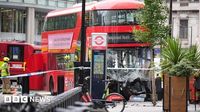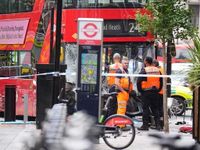On a bustling Thursday morning in central London, the ordinary rhythm of rush hour was shattered by the screech of metal and a wave of chaos. At approximately 8:20am on September 4, 2025, a Route 24 double-decker bus, bound for Hampstead Heath, veered off Victoria Street near the iconic Victoria Station—one of the city’s busiest transport hubs—and mounted the pavement, colliding with pedestrians and sending shockwaves through the heart of Westminster.
The aftermath was immediate and harrowing. According to the Metropolitan Police, seventeen people suffered injuries in the crash, including the bus driver. Of those, fifteen were swiftly transported to local hospitals, while two others were treated and discharged at the scene. Thankfully, authorities confirmed that none of the injuries were life-threatening. Still, the scene was one of distress, confusion, and concern as emergency vehicles converged on the area, their flashing lights painting a surreal tableau against the familiar London backdrop.
Eyewitness accounts captured the terror and confusion of the moment. Emit Suker, 47, who was on the bus at the time, described the ordeal to the PA news agency: “There were about 15, 16 people inside the bus. People were screaming – it was terrible.” Another bystander recounted, “I heard a massive crash, came outside and there was a woman on the floor with loads of people around her. Lots of people from the gym had run out to help her.” The sense of panic was palpable, as commuters and passersby rushed to assist the injured before emergency services arrived.
Three maintenance workers who had been standing just meters from the crash described the immediate aftermath to LBC. Sam Genders recalled, “The driver was crawling out the front of the bus covered in blood. We helped him out and dragged him over to the side. He was screaming, he was saying 'this F-ing bus, this F-ing bus'. And then he was asking if the passengers were OK.” His colleague, Mirak Kolodziej, added, “I just saw the bus driver crying out. I just ran to him, asked him if he was okay and then he just started saying ‘there's something wrong with that bus’. And then he just asked us to check the passengers. So we just ran around, opened the door and tried to get people out, everyone who we could. Without the bollards, it would have run over us.”
The physical evidence of the crash was striking. Images from the scene showed the bus’s front end crumpled, its windscreen shattered, and part of the chassis peeled away after the vehicle struck pavement bollards. A trail of diesel snaked down Allington Street, prompting police to ban smoking in the area out of fear of a secondary incident. Emergency response was swift and comprehensive: multiple police cars, ambulances, a fire engine, and London's Air Ambulance all responded to the call, as confirmed by the London Ambulance Service. “We were called at 8.20am today to reports of a road traffic collision on Victoria Street, Westminster,” a spokesperson stated. “We sent a number of resources to the scene, including ambulance crews, advanced paramedics, a paramedic in a fast response car, a clinical team manager, an incident response officer, a command support vehicle and paramedics from our hazardous area response team. We also dispatched London’s Air Ambulance. We treated 17 people in total. We took 15 patients to hospital and discharged two patients at the scene.”
As the investigation began, Detective Chief Superintendent Christina Jessah, who leads policing in the area, addressed the public’s concerns. “We understand this incident will have been very distressing to all those involved and injured and we have begun an investigation,” she said. “We are appealing for any witnesses or anyone with information to please contact us. We welcome any dashcam or mobile phone footage. We are working closely with our partners to clear the scene but the road will remain closed for the next few hours so please seek alternative routes.” The police cordoned off the area, and at least 14 bus routes were diverted to keep commuters away from the scene, creating an eerily quiet stretch in what is usually a hive of activity.
Transport for London (TfL) responded quickly, expressing its concern and commitment to uncovering the cause of the crash. Rosie Trew, TfL’s head of bus service delivery, emphasized, “Our thoughts are with the people who have been injured following a bus incident at Victoria Street. We are working with the police and the operator, Transport UK, to urgently investigate this incident. This must have been a distressing incident for everyone involved and we have support available for anyone affected.”
The incident has reignited concerns about pedestrian safety in the Victoria area, a location that has seen tragedy before. In January 2024, Catherine Finnegan, 56, from County Galway, lost her life after being struck by a double-decker bus at Victoria bus station. Just three years earlier, in August 2021, Melissa Burr, 32, was killed when a bus driver accidentally accelerated into the back of a stationary bus, pushing it into her. In both cases, the community mourned, with Finnegan’s family describing her as “a whirlwind in any room” who “lit up this world with her energy, enthusiasm for life and joy.”
Recent statistics from TfL highlight the ongoing risks. Between April and June 2025 alone, 69 people were killed or seriously injured in collisions involving London buses, including 10 pedestrians, two cyclists, and eight passengers. This marks a 17% increase over the previous year, with 17 bus-related fatalities reported in 2023—seven of whom were pedestrians. Victoria Station itself is a transport behemoth, seeing over 59 million passengers in 2023, making it the third busiest on the London Underground. The station had recently undergone works to improve pedestrian safety and accessibility, particularly for partially sighted passengers, underscoring the challenge of balancing efficiency and safety in such a high-traffic area.
For many Londoners, Thursday’s crash is a stark reminder of the unpredictability that can disrupt even the most familiar routines. As investigators sift through witness statements and dashcam footage, questions linger: Was the cause mechanical failure, human error, or something else entirely? For now, the focus remains on the recovery of those injured and the hope that lessons learned from this incident will help prevent future tragedies on the capital’s streets.
In a city that never truly stops, the echoes of that “massive crash” on Victoria Street will likely resonate for some time—both as a call for vigilance and as a testament to the resilience and compassion of London’s people in the face of sudden disaster.





